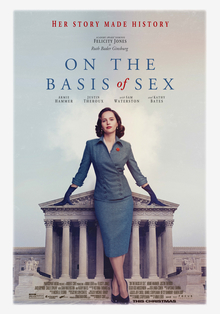
LEGAL FIGHT GETS HOLLYWOOD TREATMENT
Posted January 6th, 2019 at 8:02 pmNo Comments Yet
IN REVIEW
US JUSTICE CAST WELL IN HONEST PORTRAYAL OF CIVIL RIGHTS ICON
BY PETER THOMAS BUSCH
Felicity Jones shows her character having a particular legal skill and a profound determination to overcome the gender bias in the legal profession as only the second woman to be appointed to the Unites States Supreme Court.
On the Basis of Sex (2018), follows Ruth Bader Ginsburg as a law student and law school professor forced to pursue an alternate career path because women were not accepted into the legal profession in the same way men were.
Ginsburg was appointed as a Justice of the US Supreme Court by former US President Bill Clinton on Aug 10, 1993.
But when the US Supreme Court Justice was admitted to Harvard Law School in 1956, Ginsburg was only one of nine women in the class of 500.
Jones portrays Ginsburg as a young cautious law student disappointed at the lack of recognition merely because of her gender.

This unequal treatment gradually awakened an interest in litigating against legislation that treated people differently based on their gender.
Ginsburg personifies the equal rights movement for women as she at first seemed stuck in her role as a mother and housewife, but because of her constant challenging those outdated roles society had marked out for her, she was able to gradually overcome the gender bias in the system and also affect substantial change for equal gender rights for other women.
Jones’ character acting fits well with the role.
Jones plays multiple roles in the same movie. Jones is a student , wife, mother, then professor and associate lawyer showing the difficulty women had in succeeding in a profession career.
Jones’ character succeeds by not abandoning the roles, but by instead embracing them, gaining support from them and then succeeding in all of them and subsequently attaining individual success as a result.
Director Mimi Leder gradually develops the narrative by showing the relationships that prevented Ginsburg from succeeding in the legal profession, but also develops relationships within the narrative that helped Ginsburg succeed.
Leder intertwines three narratives into one narrative that shows how gender inequalities gradually dissolved in society. The narrative is too linear though with few surprises and too subtle plot reversals.
Armie Hammer plays Ginsburg’s loving, caring and liberal minded husband, Martin Ginsburg. Hammer shows how Ginsburg’s husband was a talented lawyer in his own right, but he was also an equal partner in the household and also a supportive father to the couple’s children.
Hammer also played Clyde Tolson in the Clint Eastwood directed biopic, J. Edgar (2011), starring Leonardo DiCaprio. DiCaprio plays an embattled J. Edgar Hoover during the early years of the US Federal Bureau of Investigations.
Kathy Bates has a cameo role as civil rights lawyer Dorothy Kenyon. Bates is cast well in the role. Generally the supporting roles in the film are cast well.
Leder makes the scenes flow more or less seamlessly despite working with a time frame of 1956 to 1972. Some time jumps do occur. Leder occasionally posts the years on the scene even though they are not necessarily entirely required.
The script tries to be entertaining without abandoning the substantive seriousness of the scholarly subject matter.
Leder also keeps the flow of the narrative compelling with interesting framing, often symbolic framing, of the scenes. Leder also moves the narrative from an atmosphere inside the home to a different atmosphere in an office to yet a different atmosphere on the sidewalk of busy New York City streets.
Leder uses different atmospheres to illustrate how gender equality often depends on circumstance.
Leder has good overall vision of the film by honestly portraying the real world challenges that women faced and continue to face for equal gender rights and for equal freedom regardless.